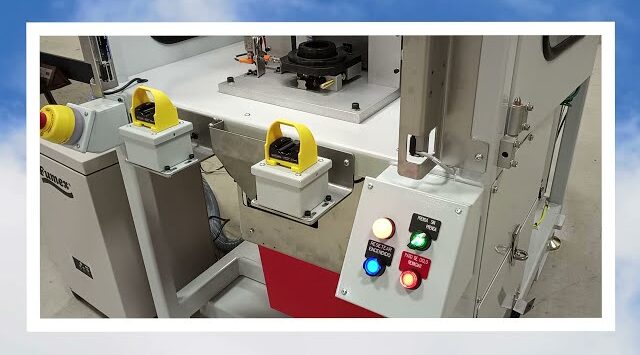SITUATION
The purchasing customer expressed the desire to expand its part assembly and part engraving operations. This presented an opportunity to automate the previously manual process of assembling and inspecting seal & sleeve components. The former antiquated process was slower using unpredictable equipment with slow output rates.
OPPORTUNITY & IMPLEMENTATION
The project requirements included the machine being completely autonomous aside from the operator loading parts into the press fixture and removing the completed parts. At its core, the requirements of this project required continuous part assembly and marking with minimal rejected parts. Multiple safety systems were incorporated, including air purification systems, electromagnetic guarding, laser shields, and light curtains to protect the operator and bystanders from all possible hazard exposures. Photoelectric Touch Safety switches start the machine operation.
Final stations include:
Air Purification System- Air purification systems are integrated to mitigate all LGACs (Laser Generated Air Contaminants) exposure. The air purification system contains a VOC indicator to detect gases in the exhaust stream. The air purification system is programmed to run when the machine is in an energized state.
Laser Marking- A laser is installed in the central part of the machine table. The laser housing protects the operator from Scattered Laser Beam Exposure. Electromagnetic safety switches on the access door protect the operator or bystanders from accessing the laser when the machine is energized.
Press Assembly- The vertical press assembly combines the sleeve parts. Light curtains protect the operator from press pinch hazards. The press pneumatic cylinder is adjustable for operator convenience.
Controls- All hard-wired control buttons use light indicators to signal the operator about the machine’s current condition.
Reject Bin- The reject chute is located in the front of the machine. The hard-wired button indicators signal to the machine operator the presence of a rejected part. Reject part counts signal to the operator the reject bin is full and is ready to be emptied.
Part Nest- A pneumatic cylinder transitions the part nest between the press station and the laser marking station. The nest is designed only to allow the sleeve parts to be installed in the correct orientation.
Laptop- The laser marking software is editable via the laptop mounted to the machine table. The laptop is assessable when the machine access doors are unlocked, or the machine is de-energized. The laser marking software allows the operator or maintenance staff to make alterations to the part engraving. The laptop is secured by a mounting plate and toe clamps to keep it secured in the proper position.
DESIGN FEATURES & SPECIFICATIONS
- Reject Chute & Bin
- Machine Access Door & Poly Guarding
- Keyence MD-U1000C UV Laser.
- Fumex Air Purification System
- Laser Marking Software
- Fixture nest pneumatic linear transfer assembly.
- AB Micrologix PLC (No HMI)
- Photoelectric Touch Safety Switches (Starting The Machine)
- Pallet Fork access on the machine frame.
Approximate Machine Dimensions: 53”L x 38”W x 66”H
Power Requirements: 480VAC, Single Phase, 20A
Pneumatic Requirements: 80PSI-10 SCFM

